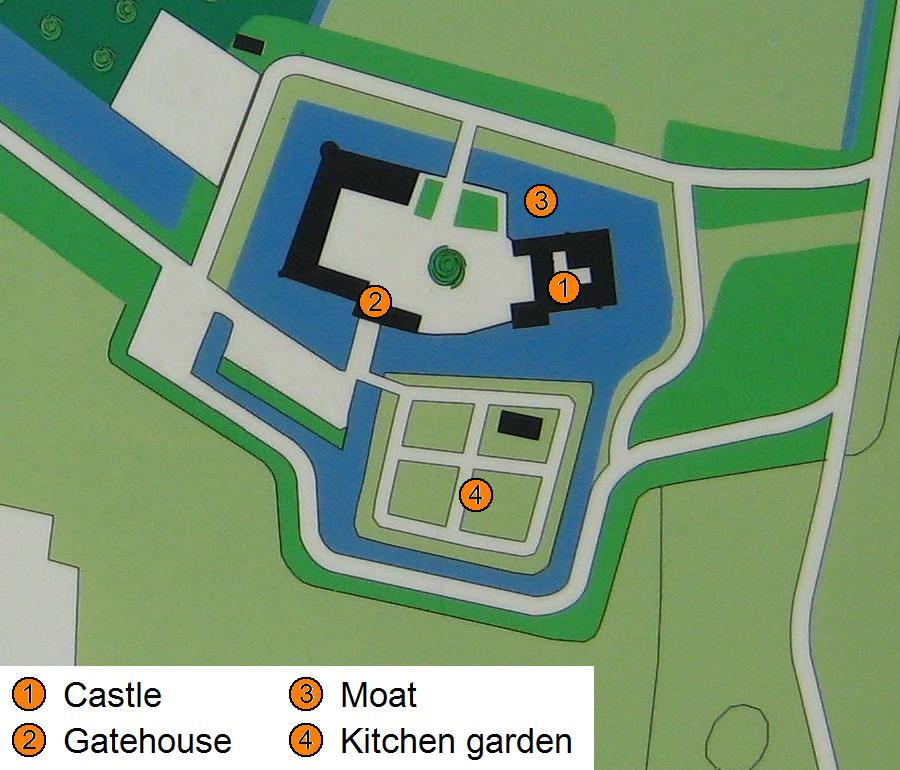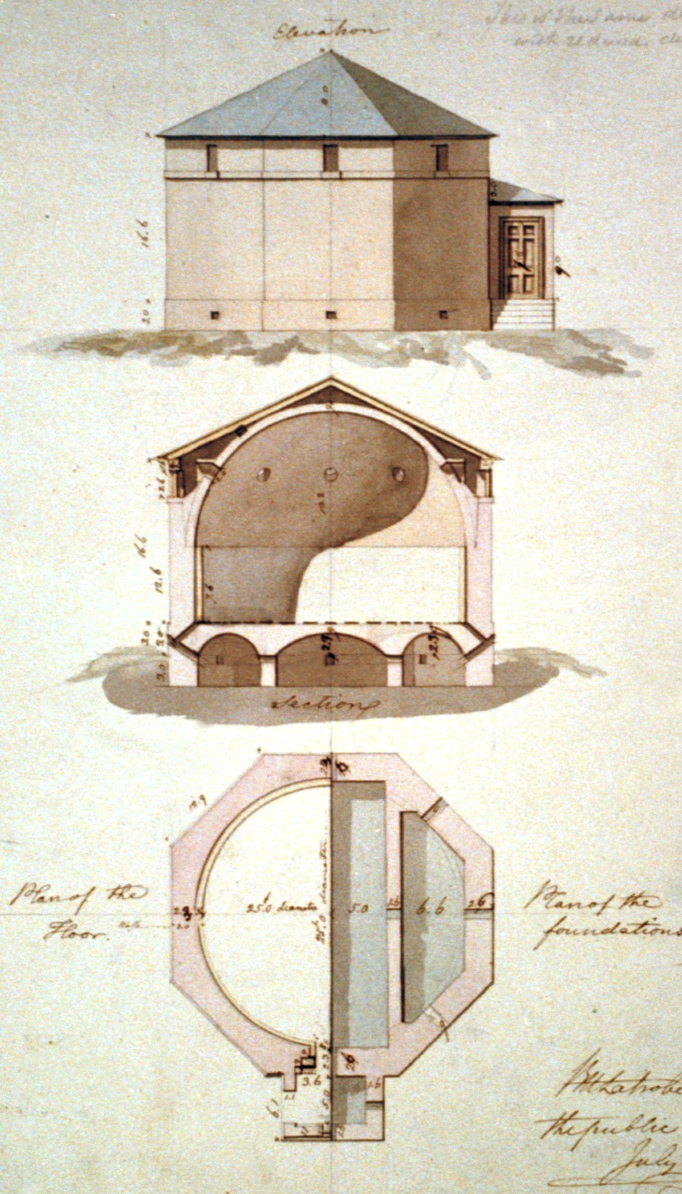|
Heusden Castle
Heusden Castle is a ruined major castle in Heusden. History In the 12th century the lords of Heusden had a territory which stretched on both sides of the Oude Maasje. At the time, this which was the main course of the Meuse. In the part south of the Oude Maasje was the main village Oudheusden with a church. In 1130 the main castle of the Lord of Heusden was near this church, on the left bank of the Oude Maasje. At that time, the village Oudheusden was simply called Heusden. In 1202 this castle was destroyed by the Duke of Brabant. After the destruction of his castle, the Lord of Heusden moved his seat to the current Heusden. Heusden was first known as . It was a new settlement north of the Oude Maasje on a meander of the Meuse. The new settlement was also east of a north-south water which connected the Oude Maasje to the Meuse. Close to this north-south connection, a new castle was built, probably as a direct consequence of this move. The first version of Heusden Castle ... [...More Info...] [...Related Items...] OR: [Wikipedia] [Google] [Baidu] |
Heusden
Heusden () is a municipality and a town in the South of the Netherlands. It is located between the towns of Waalwijk and 's-Hertogenbosch. The municipality of Heusden, including Herpt, Heesbeen, Hedikhuizen, Doeveren, and Oudheusden, merged with Drunen and Vlijmen in 1997, giving the municipality its current form. The middle part of national park the Loonse en Drunense Duinen is located in the municipality of Heusden. Population centres Heusden town Before 1997, Heusden was a municipality in itself, that included the communities of Herpt, Heesbeen, Hedikhuizen, Doeveren, and Oudheusden. Castle The settlement of Heusden on the river Meuse (Maas) started with the construction of Heusden Castle, which replaced an earlier castle destroyed by the Duke of Brabant in 1202. This fortification was quickly expanded with water works and a donjon (castle keep). The city of Heusden received city rights in 1318. Heusden's castle had belonged to successive dukes of Brabant; in ... [...More Info...] [...Related Items...] OR: [Wikipedia] [Google] [Baidu] |
Twelve Years' Truce
The Twelve Years' Truce was a ceasefire during the Eighty Years' War between Spain and the Dutch Republic, agreed in Antwerp on 9 April 1609 and ended on 9 April 1621. While European powers like France began treating the Republic as a sovereign nation, the Spanish viewed it as a temporary measure forced on them by financial exhaustion and domestic issues and did not formally recognise Dutch independence until the Treaty of Westphalia in 1648.Goodman p. 15Anderson p. 4 The Truce allowed Philip III of Spain to focus his resources elsewhere, while Archdukes Archduke Albert and Isabella used it to consolidate Habsburg rule and implement the Counter-Reformation in the Southern Netherlands. Context The war in the Low Countries reached a stalemate in the 1590s. After the fall of Antwerp in 1585, Spain's Philip II ordered Alexander Farnese to direct his military actions first towards the failed campaign of the Spanish Armada, then against France to prevent the succession of ... [...More Info...] [...Related Items...] OR: [Wikipedia] [Google] [Baidu] |
Buttress
A buttress is an architectural structure built against or projecting from a wall which serves to support or reinforce the wall. Buttresses are fairly common on more ancient buildings, as a means of providing support to act against the lateral (sideways) forces arising out of inadequately braced roof structures. The term ''counterfort'' can be synonymous with buttress and is often used when referring to dams, retaining walls and other structures holding back earth. Early examples of buttresses are found on the Eanna Temple (ancient Uruk), dating to as early as the 4th millennium BC. Terminology In addition to flying and ordinary buttresses, brick and masonry buttresses that support wall corners can be classified according to their ground plan. A clasping or clamped buttress has an L shaped ground plan surrounding the corner, an angled buttress has two buttresses meeting at the corner, a setback buttress is similar to an angled buttress but the buttresses are set back from ... [...More Info...] [...Related Items...] OR: [Wikipedia] [Google] [Baidu] |
Water Castle
A water castle is a castle whose site is largely defended by water. It can be entirely surrounded by water-filled moats (moated castle) or natural waterbodies such as island castles in a river or offshore. The term comes from European castle studies, mainly German ''Burgenkunde'', but is sometimes used in English-language popular science books and websites, and is mentioned in other more academic works. When stately homes were built in such a location, or a Wasserburg was later rebuilt as a residential manor, the German term becomes Wasserschloss, lit. "water palace/manor". Description Forde-Johnston describes such a site as "a castle in which water plays a prominent part in the defences." Apart from hindering attackers, an abundant supply of water was also an advantage during a siege. Topographically, such structures are a type of low-lying castle. Such a castle usually had only one entrance, which was via a drawbridge and that could be raised for protection in the event of a ... [...More Info...] [...Related Items...] OR: [Wikipedia] [Google] [Baidu] |
Jaap Renaud
Jacob Gerard Nicolaas (Jaap) Renaud (Voorburg, 20 February 1911 - 25 April 2007) was a Dutch archaeologist and Adjunct professor at Utrecht University. Life Family Renaud's father was a house painter supervisor. His grandfather was a school teacher, whom the young Renaud often visited. Together they would visit many castles near The Hague. Renaud would recreate these in his attic from the wood of cigar boxes, including the siege equipment. At the young age of 14 he already visited The Hague municipality archives to study the history of Binckhorst Castle and its inhabitants. In the tradition of his family Renaud also became a school teacher, but during the Great Depression he could not acquire a fixed position. He married Hanna Maartense whom he had met at the (NBAS), a student movement for alcohol abstinence. Together they visited European castles by bicycle and tent. Early career Due to cost constraints academic studies were not possible for Renaud. However, his brot ... [...More Info...] [...Related Items...] OR: [Wikipedia] [Google] [Baidu] |
Tuff
Tuff is a type of rock made of volcanic ash ejected from a vent during a volcanic eruption. Following ejection and deposition, the ash is lithified into a solid rock. Rock that contains greater than 75% ash is considered tuff, while rock containing 25% to 75% ash is described as tuffaceous (for example, ''tuffaceous sandstone''). Tuff composed of sandy volcanic material can be referred to as volcanic sandstone. Tuff is a relatively soft rock, so it has been used for construction since ancient times. Because it is common in Italy, the Romans used it often for construction. The Rapa Nui people used it to make most of the '' moai'' statues on Easter Island. Tuff can be classified as either igneous or sedimentary rock. It is usually studied in the context of igneous petrology, although it is sometimes described using sedimentological terms. Tuff is often erroneously called tufa in guidebooks and in television programmes. Volcanic ash The material that is expelled in a ... [...More Info...] [...Related Items...] OR: [Wikipedia] [Google] [Baidu] |
Formwork
Formwork is molds into which concrete or similar materials are either precast or cast-in-place. In the context of concrete construction, the falsework supports the shuttering molds. In specialty applications formwork may be permanently incorporated into the final structure, adding insulation or helping reinforce the finished structure. Types Formwork may be made of wood, metal, plastic, or composite materials: #''Traditional timber formwork''. The formwork is built on site out of timber and plywood or moisture-resistant particleboard. It is easy to produce but time-consuming for larger structures, and the plywood facing has a relatively short lifespan. It is still used extensively where the labour costs are lower than the costs for procuring reusable formwork. It is also the most flexible type of formwork, so even where other systems are in use, complicated sections may use it. #''Engineered Formwork System''. This formwork is built out of prefabricated modules with a ... [...More Info...] [...Related Items...] OR: [Wikipedia] [Google] [Baidu] |
Limestone
Limestone ( calcium carbonate ) is a type of carbonate sedimentary rock which is the main source of the material lime. It is composed mostly of the minerals calcite and aragonite, which are different crystal forms of . Limestone forms when these minerals precipitate out of water containing dissolved calcium. This can take place through both biological and nonbiological processes, though biological processes, such as the accumulation of corals and shells in the sea, have likely been more important for the last 540 million years. Limestone often contains fossils which provide scientists with information on ancient environments and on the evolution of life. About 20% to 25% of sedimentary rock is carbonate rock, and most of this is limestone. The remaining carbonate rock is mostly dolomite, a closely related rock, which contains a high percentage of the mineral dolomite, . ''Magnesian limestone'' is an obsolete and poorly-defined term used variously for dolomite, for lime ... [...More Info...] [...Related Items...] OR: [Wikipedia] [Google] [Baidu] |
Motte-and-bailey Castle
A motte-and-bailey castle is a European fortification with a wooden or stone keep situated on a raised area of ground called a motte, accompanied by a walled courtyard, or bailey, surrounded by a protective ditch and palisade. Relatively easy to build with unskilled labour, but still militarily formidable, these castles were built across northern Europe from the 10th century onwards, spreading from Normandy and Anjou in France, into the Holy Roman Empire in the 11th century. The Normans introduced the design into England and Wales. Motte-and-bailey castles were adopted in Scotland, Ireland, the Low Countries and Denmark in the 12th and 13th centuries. Windsor Castle, in England, is an example of a motte-and-bailey castle. By the end of the 13th century, the design was largely superseded by alternative forms of fortification, but the earthworks remain a prominent feature in many countries. Architecture Structures A motte-and-bailey castle was made up of two structures: a ... [...More Info...] [...Related Items...] OR: [Wikipedia] [Google] [Baidu] |
Gunpowder Magazine
A gunpowder magazine is a magazine (building) designed to store the explosive gunpowder in wooden barrels for safety. Gunpowder, until superseded, was a universal explosive used in the military and for civil engineering: both applications required storage magazines. Most magazines were purely functional and tended to be in remote and secure locations. They are the successor to the earlier powder towers and powder houses. In Australia Historic magazines were at the following locations, among others: *Jack's Magazine, Saltwater River, Victoria *Goat Island, Sydney *Spectacle Island (Port Jackson) Spectacle Island is an island in the Parramatta River and Sydney Harbour, in Sydney, Australia. It lies in the main channel of the western section of the harbour, upstream of the Harbour Bridge, adjacent to the Sydney suburb of Drummoyne. Th ... * North Arm Powder Magazine *Dry Creek explosives depot In Canada There are magazines at: *Citadel Hill (Fort George) *Citadel of Qu ... [...More Info...] [...Related Items...] OR: [Wikipedia] [Google] [Baidu] |








